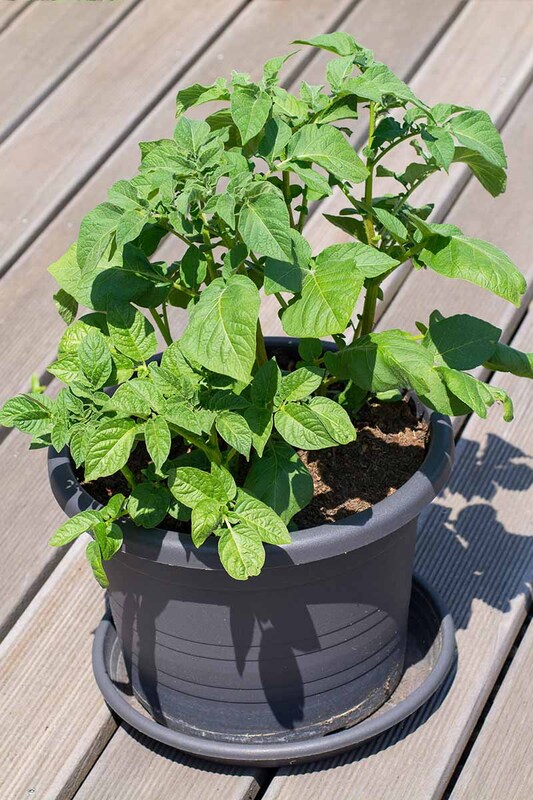|
image from gardenerspath.com. Good morning. Cold again last night. We had plants outside but put them away as it was predicted to get down to 37. During the day on Monday with the wind, and clouds it was cold out. Soon May 1st and then we can get going in our gardens. Temperature is 40 at 7:15 AM high today of 78 and low of 40 tonight. BUT we are in a slight chance of storms this afternoon with hail and wind. I had moved the tall racks into the greenhouse, they will come out but will go back in when the weather is like “wind and hail.” Soon we will be filling up the long wagons, and then they can go into the east greenhouse if weather is bad. Stay safe.
We have seed potatoes in Yukon Gold, Kennebec, Red Pontiac, and Norland Red. 5# bags. Also, I have 3 different kinds of fingerling potatoes. You slice them and plant them as a disc so out of one potato you can get many. “Fingerling” is a popular term used to describe long, thin-skinned, fingerlike potatoes that come in a variety of flavors and colors. ‘Jersey Royal,’ an English heirloom, is renowned for its snowy white flesh and flavor akin to roasted chestnuts. The Dutch red fingerling called ‘Desiree’ has rich yellow flesh and a buttery taste. Blue and purple fingerlings, such as ‘Purple Peruvian,’ have earthy flavors similar to those of mushrooms or walnuts. Because the texture of fingerlings is firm and waxy when cooked, they make an ideal potato for salads and casseroles. Waxy potatoes don’t absorb oil as readily as mealy potatoes, so they don’t go limp in salads or become soggy in casseroles. They’re also great steamed, sautéed and baked. Interesting about planting potatoes in containers. Planting potatoes in pots. I did this last year and got some potatoes. I wondered if I didn’t water enough as they could have been bigger. Give it a try, here is how to plant them. Just a reminder you add dirt as they grow, so they don’t have to push all the way through all that dirt. As you would hill them in the garden, this will give them more dirt to grow. Potatoes set on from the potato set to the top of that. Growing Potatoes in Containers by Robin Sweetser Potatoes can take up quite a bit of space in your garden. One solution is to grow potatoes in containers! Gardeners have had success growing spuds in everything from trash cans to burlap bags. Learn how to plant potatoes in pots and, importantly, how to harvest these tasty little treasures! You can start growing potatoes in pots in early spring! Wait at least two weeks after the last spring frost in your area. See the Almanac’s Frost Calculator. Start With Seed Potatoes If you have never tried growing your own potatoes, nothing could be easier. Pick up some certified seed potatoes at your local garden center. (Seed potatoes are not seeds; they are very small potatoes used to grow potato plants.) They have many colors and types of potatoes to choose from. Many container gardeners do tend to prefer small “new” potatoes in pots versus large russet types. Potato varieties are also distinguished from one another by how soon they are ready for harvest. Early varieties are good because you get your rewards sooner but late varieties will produce higher yields if properly cared for. One rule of thumb is to plant seed potatoes that are about the size of a hen’s egg whole and to cut the larger ones. Types of Containers for Potatoes Any large container can be used for growing potatoes as long as it has good drainage and opaque (and doesn’t let light through). Trash cans are great, especially ones on wheels. Just be sure to drill lots of drainage holes in the bottom and a few inches up the sides. The container needs to be at least 14 inches deep with a 10 to 15 gallon capacity. Avoiding getting much larger as it gets difficult to water evenly. You’ll need five gallons of soil volume for each plant. If your container has a diameter of 20 inches, you can assume 4 plants. How to Fill Containers To fill your container, you’ll want to use half “soilless” potting mix and half well-rotted compost to enrich the soil. You can find bags at garden centers. Never use fresh manure. Also, if you’re not planting in the ground, do NOT use soil. It compacts in a container, doesn’t drain well, causes rotting, and often carries weed seeds or disease. Potting mix retains moisture but also drains well; compost adds fertility. How to Plant Container Potatoes Position your potato pots where they will get 6 to 8 hours of sunshine a day. Fill your container with 4 to 6 inches of soil. Potatoes prefer a slightly acid soil so leave out the lime, which encourages scab. Plant each piece and cover with another 2 inches of soil. Plant pieces 5 to 6 inches apart and 3 to 4 inches away from the sides of the container. As the plants grow, gently add soil around the base of the plants; it is okay to cover some of the leaves as long as the top 2/3 or so of the plant still sticks out of the soil. It is important to keep the stems of the plant covered as they grow because your potatoes grow on short runners which are called stolons that are formed on the sides of the underground stalk. The longer the stalk the more potatoes you’ll get, especially if you are growing a late season variety. How to Feed and Water Container Potatoes Water whenever the top 1 to 2 inches of potting soil feels dry to the touch, and apply enough water for some to escape out of the bottom drainage holes. The aim is for “moist,” not soggy. After the plants have blossomed, potatoes will start to form. When to Harvest Potatoes in Containers If you can easily dig around the plants without disturbing the roots too much you can pick some of these small new potatoes to eat. They’re tender and delicious! Or, wait until the tops of the plants completely die down in the fall to harvest the full crop. Or harvest after the first frost in the fall. If you wish, you can gently tip the entire container or trash can onto a tarp, then gently sift through and unearth those treasures. Do this in a shady area as tubers should not be exposed to light. Don’t be too rough; potatoes can bruise. Also, do not wash your potatoes until you are ready to eat them or you risk rot. Just brush off most of the soil before storing in a dark, cool place such as a basement or root cellar. For a minimum amount of effort you can treat your family to the gourmet delight of home-grown potatoes. Their flavor and texture is far superior to store-bought spuds. Taken from https://www.almanac.com/growing-potatoes-containers Till next time this is Becky Litterer, Becky’s Greenhouse, Dougherty Iowa [email protected] 641-794-3337 cell 641-903-9365
0 Comments
Leave a Reply. |
AuthorHi! My name is Becky and I am a Master Gardener. I own Becky's Greenhouse in Dougherty, Iowa. Archives
March 2024
Categories |
|


 RSS Feed
RSS Feed
